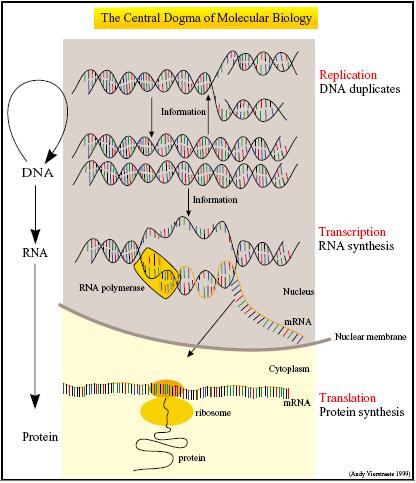Chassis/Cell-Free Systems
Cell-Free Systems
Introduction
Cell-Free Systems (CFS) involve the in-vitro expression of genes into proteins. These systems can serve as a compatible chassis for the various parts and devices from the Registry of Standard Biological Parts.
The Central Dogma describes gene expression in terms of two essential processes - the transcription of DNA into messenger RNA (mRNA) and the translation of mRNA into polypeptides. 1 Not only do CFS house the molecular machinery necessary for transcription and translation, they are also optimized for these two processes.
Coupled transcription-translation systems usually combine a bacteriophage RNA polymerase and promoter with eukaryotic or prokaryotic extracts rich in ribosomes, transfer RNAs and aminoacyl-tRNA transferase enzymes. Buffers are also added to maintain the appropriate magnesium and salt concentrations required for efficient translation. In addition, an ATP regenerating system involving either creatine phosphate and creatine kinase or phosphoenolpyruvate and pyruvate kinase is used to power and prolong the lifespan of the expression machinery 2.
A good analogy compared this transcription-translation machinery of the CFS to the hardware and the synthetic DNA to the software. 3 This gives an apt illustration of the ease of building genetically engineered machines using the cell-free approach. Simply by adding the DNA template to the cell extract and feeding solution, the CFS would be able to express the encoded genetic circuit.
The PURE system has recently been developed as a reconstituted CFS for synthesizing proteins using recombinant elements 4. This purely synthetic expression system enables even better quality control over the reaction conditions.
Advantages and disadvantages of CFS
| System is cell-free and therefore has no risk of infecting people with diseases | Short expression lifespan because of limited energy of the system even in the presence of an ATP regenerating system |
| Process is quick and simple requiring only preparation of cell extract and feeding solution and subsequent addition of DNA template | Expensive because each reaction mixture can only be used for a single reaction which lasts for about 6 hours; system does not self-regenerate |
| Expression system can be quality-controlled by manipulating adjustable parameters e.g. buffers are added to maintain optimum magnesium concentrations for efficient translation; protease inhibitors can be added to minimize degradation of synthesized proteins | Less characterization and experience of use in the laboratories compared to E. coli |
Specifications for CFS characterization
Several parameters are identified to help us understand the advantages and disadvantages associated with using a particular chassis.
| Properties | |
| Basic criterion for a chassis | Ability to express Biobricks |
| Optimum temperature | Temperature at which expression rate reaches a maximum value. |
| Optimum amount of DNA | Amount of DNA required for expression rate to reach a maximum value. |
| Product stability | Measure of the half-life of a given protein (e.g. GFP) synthesized in the chassis. |
| Peak time Expression lifespan |
Measure of time from start of reaction to the point when expression rate reaches the maximum value Measure of time from start of reaction to the point when protein degradation overrides protein synthesis |
| Expression capacity | Measure of the total expression of a chassis for a given DNA construct template. This should take into account the degradation of synthesized protein. |
To gain knowledge about the CFS chassis, we have selected the following parts available in the registry to extract the above-mentioned properties.
- A simple constitutive gene expression device that reguires an E. coli RNA polymerase BBa_I13522
- A simple constitutive gene expression device that requires a T7 bacteriophage RNA polymerase BBa_R0085
- An inducible gene expression device that is well-characterized in the registry BBa_T9002
Cell-Free Systems modelling
- To understand better some of the specificities of this new chassis we have built a basic model.
- Our study investigates the mechanism of constitutive gene expression, inside a cell-free system with limited resources.
- Read more about our model.
Cell-Free Systems investigated
Please click on each system for its individual characterization.
| Homemade E. coli S30 | Commercial E. coli S30 | Commercial E. coli T7 S30 | Vesicle-encapsulation |
Different compartmentalization strategies
| Batch-mode | Transcription-translation reaction is carried out in bulk solution. |
| Continuous-exchange | Transcription-translation reaction is separated from feeding solution by a dialysis membrane. |
| Vesicle-encapsulated | The reaction is separated from feeding solution by a phospholipid bilayer. More reliable exchange of materials is established by inserting a non-specific pore protein into the phospholipid bilayer.2 |
DNA constructs selected for CFS characterization
- A simple constitutive gene expression device that reguires an E. coli RNA polymerase BBa_I13522
- A simple constitutive gene expression device that requires a T7 bacteriophage RNA polymerase BBa_R0085
- An inducible gene expression device that is well-characterized in the registry BBa_T9002
References
<biblio>
- 1 pmid=4913914
- 2 pmid=15183761
- 3 pmid=16224117
- 4 pmid=16076456
- 5 pmid=14559971
</biblio>

